[English] 日本語
 Yorodumi
Yorodumi- PDB-5k0y: m48S late-stage initiation complex, purified from rabbit reticulo... -
+ Open data
Open data
- Basic information
Basic information
| Entry | Database: PDB / ID: 5k0y | |||||||||||||||||||||||||||||||||
|---|---|---|---|---|---|---|---|---|---|---|---|---|---|---|---|---|---|---|---|---|---|---|---|---|---|---|---|---|---|---|---|---|---|---|
| Title | m48S late-stage initiation complex, purified from rabbit reticulocytes lysates, displaying eIF2 ternary complex and eIF3 i and g subunits relocated to the intersubunit face | |||||||||||||||||||||||||||||||||
 Components Components |
| |||||||||||||||||||||||||||||||||
 Keywords Keywords | TRANSLATION / eukaryotic translation initiation / ribosome / eIF3 peripheral subunits / cryo-EM | |||||||||||||||||||||||||||||||||
| Function / homology |  Function and homology information Function and homology informationviral translational termination-reinitiation / eukaryotic translation initiation factor 3 complex, eIF3m / eukaryotic translation initiation factor 2 complex / formation of cytoplasmic translation initiation complex / eukaryotic translation initiation factor 3 complex / eukaryotic 43S preinitiation complex / formation of translation preinitiation complex / eukaryotic 48S preinitiation complex / cellular response to chemical stress / protein-synthesizing GTPase ...viral translational termination-reinitiation / eukaryotic translation initiation factor 3 complex, eIF3m / eukaryotic translation initiation factor 2 complex / formation of cytoplasmic translation initiation complex / eukaryotic translation initiation factor 3 complex / eukaryotic 43S preinitiation complex / formation of translation preinitiation complex / eukaryotic 48S preinitiation complex / cellular response to chemical stress / protein-synthesizing GTPase / Formation of the ternary complex, and subsequently, the 43S complex / laminin receptor activity / Ribosomal scanning and start codon recognition / Translation initiation complex formation / Formation of a pool of free 40S subunits / ubiquitin ligase inhibitor activity / positive regulation of signal transduction by p53 class mediator / 90S preribosome / GTP hydrolysis and joining of the 60S ribosomal subunit / L13a-mediated translational silencing of Ceruloplasmin expression / regulation of translational fidelity / phagocytic cup / laminin binding / rough endoplasmic reticulum / translation regulator activity / ribosomal small subunit export from nucleus / gastrulation / translation initiation factor activity / MDM2/MDM4 family protein binding / cytosolic ribosome / class I DNA-(apurinic or apyrimidinic site) endonuclease activity / DNA-(apurinic or apyrimidinic site) lyase / response to endoplasmic reticulum stress / maturation of LSU-rRNA from tricistronic rRNA transcript (SSU-rRNA, 5.8S rRNA, LSU-rRNA) / positive regulation of apoptotic signaling pathway / maturation of SSU-rRNA from tricistronic rRNA transcript (SSU-rRNA, 5.8S rRNA, LSU-rRNA) / maturation of SSU-rRNA / translational initiation / small-subunit processome / spindle / cytoplasmic stress granule / rRNA processing / positive regulation of canonical Wnt signaling pathway / rhythmic process / regulation of translation / ribosome binding / virus receptor activity / ribosomal small subunit biogenesis / ribosomal small subunit assembly / small ribosomal subunit / small ribosomal subunit rRNA binding / cytosolic small ribosomal subunit / perikaryon / cytosolic large ribosomal subunit / cytoplasmic translation / cell differentiation / tRNA binding / mitochondrial inner membrane / postsynaptic density / rRNA binding / structural constituent of ribosome / ribosome / translation / ribonucleoprotein complex / cell division / DNA repair / mRNA binding / GTPase activity / apoptotic process / synapse / dendrite / centrosome / GTP binding / nucleolus / perinuclear region of cytoplasm / Golgi apparatus / DNA binding / RNA binding / zinc ion binding / nucleus / membrane / plasma membrane / cytosol / cytoplasm Similarity search - Function | |||||||||||||||||||||||||||||||||
| Biological species |   Homo sapiens (human) Homo sapiens (human) | |||||||||||||||||||||||||||||||||
| Method | ELECTRON MICROSCOPY / single particle reconstruction / cryo EM / Resolution: 5.8 Å | |||||||||||||||||||||||||||||||||
 Authors Authors | Simonetti, A. / Brito Querido, J. / Myasnikov, A.G. / Mancera-Martinez, E. / Renaud, A. / Kuhn, L. / Hashem, Y. | |||||||||||||||||||||||||||||||||
| Funding support |  France, 2items France, 2items
| |||||||||||||||||||||||||||||||||
 Citation Citation |  Journal: Mol Cell / Year: 2016 Journal: Mol Cell / Year: 2016Title: eIF3 Peripheral Subunits Rearrangement after mRNA Binding and Start-Codon Recognition. Authors: Angelita Simonetti / Jailson Brito Querido / Alexander G Myasnikov / Eder Mancera-Martinez / Adeline Renaud / Lauriane Kuhn / Yaser Hashem /  Abstract: mRNA translation initiation in eukaryotes requires the cooperation of a dozen eukaryotic initiation factors (eIFs) forming several complexes, which leads to mRNA attachment to the small ribosomal ...mRNA translation initiation in eukaryotes requires the cooperation of a dozen eukaryotic initiation factors (eIFs) forming several complexes, which leads to mRNA attachment to the small ribosomal 40S subunit, mRNA scanning for start codon, and accommodation of initiator tRNA at the 40S P site. eIF3, composed of 13 subunits, 8 core (a, c, e, f, h, l, k, and m) and 5 peripheral (b, d, g, i, and j), plays a central role during this process. Here we report a cryo-electron microscopy structure of a mammalian 48S initiation complex at 5.8 Å resolution. It shows the relocation of subunits eIF3i and eIF3g to the 40S intersubunit face on the GTPase binding site, at a late stage in initiation. On the basis of a previous study, we demonstrate the relocation of eIF3b to the 40S intersubunit face, binding below the eIF2-Met-tRNAi(Met) ternary complex upon mRNA attachment. Our analysis reveals the deep rearrangement of eIF3 and unravels the molecular mechanism underlying eIF3 function in mRNA scanning and timing of ribosomal subunit joining. | |||||||||||||||||||||||||||||||||
| History |
|
- Structure visualization
Structure visualization
| Movie |
 Movie viewer Movie viewer |
|---|---|
| Structure viewer | Molecule:  Molmil Molmil Jmol/JSmol Jmol/JSmol |
- Downloads & links
Downloads & links
- Download
Download
| PDBx/mmCIF format |  5k0y.cif.gz 5k0y.cif.gz | 1.9 MB | Display |  PDBx/mmCIF format PDBx/mmCIF format |
|---|---|---|---|---|
| PDB format |  pdb5k0y.ent.gz pdb5k0y.ent.gz | 1.4 MB | Display |  PDB format PDB format |
| PDBx/mmJSON format |  5k0y.json.gz 5k0y.json.gz | Tree view |  PDBx/mmJSON format PDBx/mmJSON format | |
| Others |  Other downloads Other downloads |
-Validation report
| Summary document |  5k0y_validation.pdf.gz 5k0y_validation.pdf.gz | 1.3 MB | Display |  wwPDB validaton report wwPDB validaton report |
|---|---|---|---|---|
| Full document |  5k0y_full_validation.pdf.gz 5k0y_full_validation.pdf.gz | 1.4 MB | Display | |
| Data in XML |  5k0y_validation.xml.gz 5k0y_validation.xml.gz | 163.5 KB | Display | |
| Data in CIF |  5k0y_validation.cif.gz 5k0y_validation.cif.gz | 286.7 KB | Display | |
| Arichive directory |  https://data.pdbj.org/pub/pdb/validation_reports/k0/5k0y https://data.pdbj.org/pub/pdb/validation_reports/k0/5k0y ftp://data.pdbj.org/pub/pdb/validation_reports/k0/5k0y ftp://data.pdbj.org/pub/pdb/validation_reports/k0/5k0y | HTTPS FTP |
-Related structure data
| Related structure data |  8190MC  8195C  5k1hC M: map data used to model this data C: citing same article ( |
|---|---|
| Similar structure data |
- Links
Links
- Assembly
Assembly
| Deposited unit | 
|
|---|---|
| 1 |
|
- Components
Components
-RNA chain , 3 types, 3 molecules NAF
| #1: RNA chain | Mass: 24231.510 Da / Num. of mol.: 1 Source method: isolated from a genetically manipulated source Details: tRNAiMet / Source: (gene. exp.)   |
|---|---|
| #2: RNA chain | Mass: 572789.812 Da / Num. of mol.: 1 Source method: isolated from a genetically manipulated source Source: (gene. exp.)   |
| #3: RNA chain | Mass: 9603.775 Da / Num. of mol.: 1 Source method: isolated from a genetically manipulated source Details: Beta-Globin mRNA / Source: (gene. exp.)   |
-Protein , 1 types, 1 molecules P
| #4: Protein | Mass: 30633.297 Da / Num. of mol.: 1 Source method: isolated from a genetically manipulated source Source: (gene. exp.)   |
|---|
+Ribosomal protein ... , 26 types, 26 molecules GHJKLQRUVWXZacefghijklmnpt
-40S ribosomal protein ... , 7 types, 7 molecules IYboqrs
| #7: Protein | Mass: 29658.920 Da / Num. of mol.: 1 Source method: isolated from a genetically manipulated source Source: (gene. exp.)   |
|---|---|
| #21: Protein | Mass: 9480.186 Da / Num. of mol.: 1 Source method: isolated from a genetically manipulated source Source: (gene. exp.)   |
| #24: Protein | Mass: 8896.102 Da / Num. of mol.: 1 Source method: isolated from a genetically manipulated source Source: (gene. exp.)   |
| #37: Protein | Mass: 23902.871 Da / Num. of mol.: 1 Source method: isolated from a genetically manipulated source Source: (gene. exp.)   |
| #39: Protein | Mass: 27471.535 Da / Num. of mol.: 1 Source method: isolated from a genetically manipulated source Source: (gene. exp.)   |
| #40: Protein | Mass: 13766.122 Da / Num. of mol.: 1 Source method: isolated from a genetically manipulated source Source: (gene. exp.)   |
| #41: Protein | Mass: 15188.970 Da / Num. of mol.: 1 Source method: isolated from a genetically manipulated source Source: (gene. exp.)   |
-Eukaryotic translation initiation factor 3 subunit ... , 3 types, 3 molecules MOT
| #11: Protein/peptide | Mass: 4124.495 Da / Num. of mol.: 1 Source method: isolated from a genetically manipulated source Source: (gene. exp.)  Homo sapiens (human) / Gene: EIF3G, EIF3S4 / Production host: Homo sapiens (human) / Gene: EIF3G, EIF3S4 / Production host:  Homo sapiens (human) / References: UniProt: O75821 Homo sapiens (human) / References: UniProt: O75821 |
|---|---|
| #12: Protein | Mass: 8675.697 Da / Num. of mol.: 1 Source method: isolated from a genetically manipulated source Source: (gene. exp.)  Homo sapiens (human) / Gene: EIF3G, EIF3S4 / Production host: Homo sapiens (human) / Gene: EIF3G, EIF3S4 / Production host:  Homo sapiens (human) / References: UniProt: O75821 Homo sapiens (human) / References: UniProt: O75821 |
| #16: Protein | Mass: 37039.328 Da / Num. of mol.: 1 Source method: isolated from a genetically manipulated source Source: (gene. exp.)   |
-Eukaryotic initiation factor 2 ... , 2 types, 2 molecules Sd
| #15: Protein | Mass: 45862.441 Da / Num. of mol.: 1 Source method: isolated from a genetically manipulated source Source: (gene. exp.)   |
|---|---|
| #26: Protein/peptide | Mass: 2103.416 Da / Num. of mol.: 1 Source method: isolated from a genetically manipulated source Source: (gene. exp.)   |
-Details
| Has protein modification | Y |
|---|
-Experimental details
-Experiment
| Experiment | Method: ELECTRON MICROSCOPY |
|---|---|
| EM experiment | Aggregation state: PARTICLE / 3D reconstruction method: single particle reconstruction |
- Sample preparation
Sample preparation
| Component | Name: m48S late-stage initiation complex, purified from rabbit reticulocytes lysates, displaying eIF2 ternary complex and eIF3 i and g subunits relocated to the intersubunit face Type: COMPLEX / Entity ID: all / Source: MULTIPLE SOURCES |
|---|---|
| Molecular weight | Value: 2 MDa / Experimental value: NO |
| Buffer solution | pH: 7.6 |
| Specimen | Conc.: 0.5 mg/ml / Embedding applied: NO / Shadowing applied: NO / Staining applied: NO / Vitrification applied: YES |
| Specimen support | Grid material: COPPER / Grid mesh size: 400 divisions/in. / Grid type: Quantifoil |
| Vitrification | Instrument: FEI VITROBOT MARK IV / Cryogen name: ETHANE / Humidity: 100 % / Chamber temperature: 277 K |
- Electron microscopy imaging
Electron microscopy imaging
| Experimental equipment |  Model: Titan Krios / Image courtesy: FEI Company |
|---|---|
| Microscopy | Model: FEI TITAN KRIOS |
| Electron gun | Electron source:  FIELD EMISSION GUN / Accelerating voltage: 300 kV / Illumination mode: FLOOD BEAM FIELD EMISSION GUN / Accelerating voltage: 300 kV / Illumination mode: FLOOD BEAM |
| Electron lens | Mode: BRIGHT FIELD / Nominal magnification: 59000 X / Nominal defocus max: 4500 nm / Nominal defocus min: 800 nm / Cs: 0.01 mm / C2 aperture diameter: 100 µm |
| Specimen holder | Cryogen: NITROGEN / Specimen holder model: FEI TITAN KRIOS AUTOGRID HOLDER |
| Image recording | Average exposure time: 1.5 sec. / Electron dose: 24 e/Å2 / Detector mode: INTEGRATING / Film or detector model: FEI FALCON II (4k x 4k) / Num. of grids imaged: 1 / Num. of real images: 5700 |
| Image scans | Sampling size: 14 µm / Movie frames/image: 7 / Used frames/image: 2-8 |
- Processing
Processing
| EM software |
| ||||||||||||||||||||||||||||||||||||||||
|---|---|---|---|---|---|---|---|---|---|---|---|---|---|---|---|---|---|---|---|---|---|---|---|---|---|---|---|---|---|---|---|---|---|---|---|---|---|---|---|---|---|
| CTF correction | Type: PHASE FLIPPING AND AMPLITUDE CORRECTION | ||||||||||||||||||||||||||||||||||||||||
| 3D reconstruction | Resolution: 5.8 Å / Resolution method: FSC 0.143 CUT-OFF / Num. of particles: 475000 / Algorithm: FOURIER SPACE / Num. of class averages: 10 / Symmetry type: POINT | ||||||||||||||||||||||||||||||||||||||||
| Atomic model building | Protocol: FLEXIBLE FIT | ||||||||||||||||||||||||||||||||||||||||
| Atomic model building | PDB-ID: 4KZY Accession code: 4KZY / Source name: PDB / Type: experimental model |
 Movie
Movie Controller
Controller


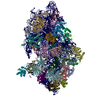

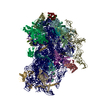
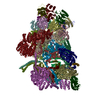
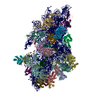



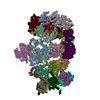
 PDBj
PDBj



































